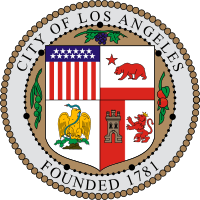Crestwood Hills, Los Angeles
Crestwood Hills is a neighborhood within Brentwood, Los Angeles, California, located on the ridges to the north and east of Kenter Canyon in the Santa Monica Mountains. It is best known for its mid-century modern architecture, and contains several homes designated as architectural landmarks by the State of California. The homes were designed by A. Quincy Jones, and are featured in numerous magazines, articles, and books about mid-century modern housing. The community includes a park, pre-school, and homeowners' association.
Crestwood Hills began as a utopian experiment in the late 1940s by a few musicians, and eventually turned into a cooperative association that included 400 members. The project was initially called the Mutual Housing Tract, before changing to Crestwood Hills. It was intended as a multi-ethnic project, but pressure on the landowner from existing Brentwood residents - this was still the era of racially and religiously restrictive housing covenants - eventually led to some members of the original group to being dropped as a condition of finalizing the sale. The 1961 Brentwood-Bel-Air fire lead to the destruction of 49 homes. Brenda Rees of the Los Angeles Times said "decades of construction and reconstruction erased much of the original modern design."[1] By 2000 Crestwood Hills was a wealthy neighborhood.[1]
Education
Crestwood Hills is within the Los Angeles Unified School District.
The community also maintains its own cooperative preschool, and parents who send their children there are required to volunteer two or three times a month.[1] Dues paying members of the Crestwood Hills Homeowners Association receive priority admission to the school.
Parks and recreation
Crestwood Hills Park is located in Crestwood Hills. The park has barbecue pits, unlighted outdoor basketball courts, a children's play area, a community room with a capacity of 90 people, hiking trails, a kitchen, and picnic tables.[2]
Notable residents
- Marvin Braude (1920–2005), member of the Los Angeles City Council between 1965 and 1997
- David Baerwald (1960-), award-winning songwriter, composer and lyricist.
References
- 1 2 3 "Evolution of a '50s Dream; Crestwood Hills began as an experiment in cooperative living and modern architecture. Today, it's an upper- crust neighborhood trying to renew the community spirit and preserve its architectural heritage." Los Angeles Times. April 24, 2000. Southern California living, Part E, Page 1. Retrieved on March 19, 2010.
- ↑ "Crestwood Hills Park." City of Los Angeles. Retrieved on March 19, 2010.
There was an article in the Getty Magazine during the 1990s that detailed the social and architectural history of the project.

